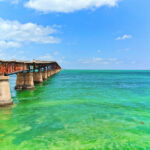Did you know that there is a type of deer found only in the Florida Keys? The Key Deer is a very small species of deer that lives in the Lower Keys. Listed on the Federal Endangered Species List, this animal is unique in its location and size, but is a pretty normal deer if you’re used to seeing them. If you’re looking to see key deer, we’ve got tips on where to go and how to safely observe them.
From the visitor center to places on Big Pine Key where you can find key deer, we’ve got all the information you need. If you have any questions about seeing key deer or any other types of wildlife during your Florida Keys trip, please leave a comment or send us a note. We’re always happy to share more!

What’s Special about Key Deer?
As you’re driving through the Florida Keys, and in particular when you get into the Lower Keys, you’ll see signs warning you of deer crossing. This is for the key deer which are smaller than you might expect, so if they’re crossing the road they might not be as eye-catching. The largest bucks grow to less than a yard high (3 feet tall) at the shoulders and weigh about 80 pounds. The females (does) are 24 to 28 inches at the shoulders and weigh about 65 pounds. My kids haven’t been this small for years.
Being so small, the Key Deer could be mistaken for dogs if you’re driving and not intently looking for them. I’ll tell you though, even when you get to Big Pine Key, where most of the Key Deer are concentrated, it’s rare to actually see them near the Overseas Highway. If you’re staying on Big Pine Key, you’ll likely see them in the neighborhoods during your stay, but typically not just while you’re driving.

National Key Deer Refuge Info
Before you go looking for Key Deer in the wild, be sure that you stop into the National Key Deer Refuge Nature Center. Here you’ll be able to learn about the dear and other wildlife in the area, you can see taxidermy and skeleton specimens and talk to the volunteers about the seeing Key Deer (they may have tips for you). There are also restrooms here at the visitor center, which is great if you’ve been driving from the Upper Keys and need a break. Once you’ve toured the center, it’s time to look for the Key Deer.

Where to See Key Deer
Big Pine Key is THE island for seeing Key Deer. As I mentioned, they don’t just hang out along the Overseas Highway, but they’re there. If you’re driving through the Key Deer Refuge, keep your eyes peeled in the bare forest. Often they can be spotted darting between the old trees, but they are small, so they’re a bit sneaky.
For the best chance of seeing Key Deer, head to the Blue Hole. Here you’ll be able to walk the trails around the small lake and will likely see Key Deer all around it. This is also a great birdwatching spot, and if you’re lucky you may even see the resident alligator in the Blue Hole.

Key Deer Safety Tips
Remember that Key Deer are indeed wild animals. True, they are deer and in general are very docile, but they are still wild and need to stay that way. The Key Deer is a protected species and is listed on the Federal Endangered Species List, meaning that there are penalties for harming or potentially harming the deer. This means that you do NOT do any of the following:
- feed the deer
- pet them
- approach them to closely
- try to lead the deer.
I know this seems like common sense, but really that sort of logic just isn’t so common. We love the Key Deer and want to see them continue to have the population recover, but humans can be really human about things… Having said all this, unfortunately a lot of Key Deer have lost their fear of humans and actually can be pretty aggressive trying to get human food. If you’re stopped at the Blue Hole and a deer sees you eating a snack, they may aggressively try to get it from you. Be careful!

Key Deer Refuge Visitor Center Operating Information
To be sure you have the best experience seeing Key Deer and that you get to stop into the Refuge Visitor Center, here’s the operating information for your visit:
- Operating Dates/Season: year round, Wednesday – Saturday from 10:00 am to 3:00 pm
- Office phone number: 305-872-0774
- Company website: National Wildlife Refuge
- Visitor Center address: 30587 Overseas Highway, Big Pine Key, FL33043




Pingback: Hotel Laureate - a Beautiful All-Suites Hotel in Key West
Pingback: Great Things to do on Marathon and the Lower Keys - The Keys Explored